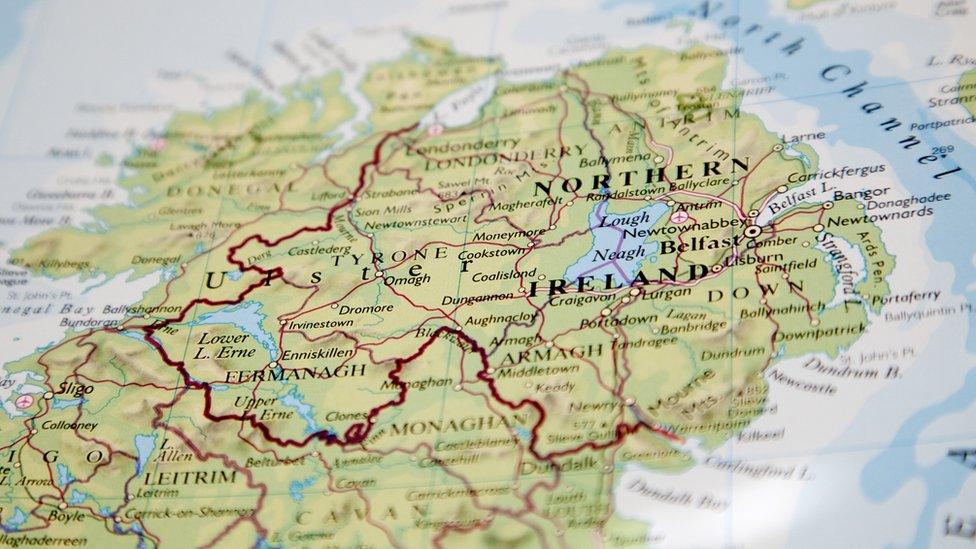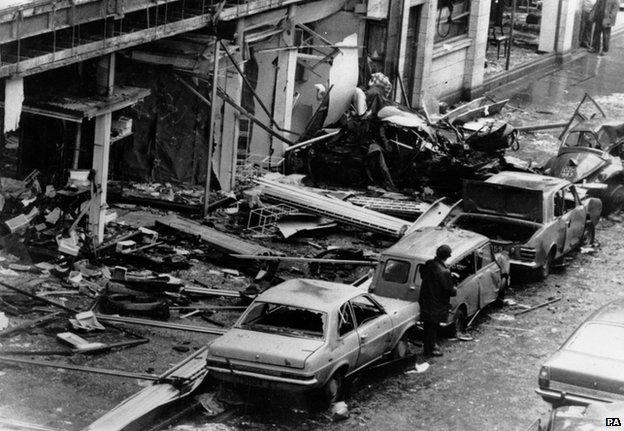Irish state papers show 1975 proposal to change border
- Published

The border between Northern Ireland and the Republic of Ireland was established in 1921
Officials discussed the possibility of redrawing the border between Northern Ireland and the Republic in the 1970s, Irish state archives have revealed.
Reducing the size of NI was one option proposed by Dublin civil servants in response to escalating violence during the Troubles.
They were asked to consider the costs and consequences of such a scenario.
The 1975 discussion paper has been made public for the first time as part of the annual release of state papers.
The previously secret document was entitled the "Negotiated Repartition of Northern Ireland" and contained a proposal to transfer swathes of land and hundreds of thousands of residents from north to south.
It was drawn up at the request of the Irish cabinet, following the collapse of the Sunningdale Agreement, external along with Stormont's nascent power-sharing government in 1974.
The Irish government wanted to prepare itself for all eventualities, including a possible British withdrawal, large-scale violence and even civil war.
'Economic burden'
The discussion paper's authors envisioned a range of possibilities for the path of a new land border but even the most conservative would have seen many towns and villages transferred into the Republic of Ireland, with only County Antrim left intact.
Under the option for maximum change, two thirds of Northern Ireland's territory would have become part of the Republic, with all of County Fermanagh and large parts of counties Tyrone, Down, Armagh and Londonderry changing hands.
According to Irish broadcaster RTÉ, external, this option would have involved 486,000 residents (285,000 Catholics and 201,000 non-Catholics) moving from north to south.
The costs of redrawing the border and rehousing affected residents were estimated at up to £873m at the time - a figure exceeding £7bn in today's money.
But officials also suggested there would be a "tremendous economic burden" if the border was forcibly redrawn as a result of large-scale violence.

Dublin and Monaghan were bombed by loyalists the year before the discussion paper was produced
The discussion paper also examined the consequences of possible Irish military intervention in Northern Ireland to "subdue loyalist resistance".
Irish government advisors concluded that this option would be "beyond our military and administrative capabilities".
The 1975 plan was not needed but it was not the first time that the Irish government had put forward its own proposals to change the borderline.
When the island of Ireland was partitioned in 1921 the Anglo-Irish Treaty stated that a commission would be set up to determine the future boundary of the recently established Northern Ireland.
However, due to the outbreak of the Irish Civil War, the Irish Boundary Commission did not hold its first meeting until 1924.
The commission's proposals were partially leaked to the Morning Post newspaper in November 1925 and the report horrified the Irish government, which had not anticipated it would lose any of its territory to Northern Ireland.
The Irish Free State's then leader, WT Cosgrave, went to London for talks and the two governments agreed to shelve the commission's recommendations and keep the border to its original 1921 path.
Related topics
- Published29 December 2023

- Published28 December 2023

- Published27 December 2023
